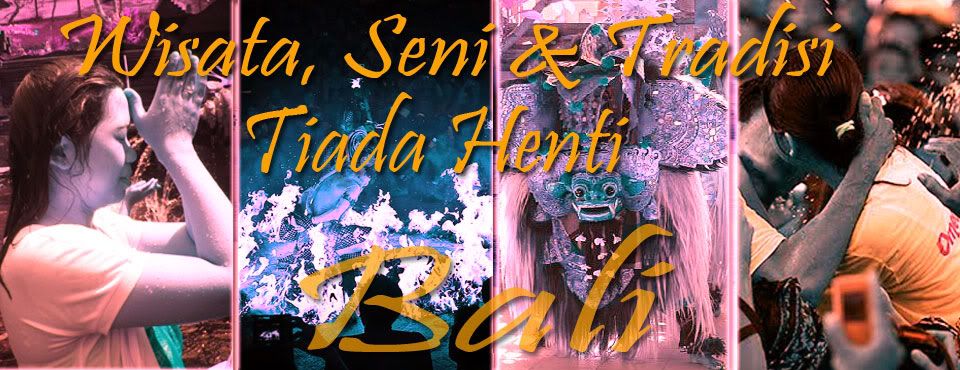Pesta Kesenian Bali
 Seni
yang ditampilkan adalah persembahan dan karya cipta yang dihasilkan juga
sebagai persembahan. Hal ini yang masih dijadikan. Persembahan seni dan
karya cipta mengandung makna pembebasan yang iklas yang dalam ajaran
Hindu sering disebut dengan yadnya. Yadnya yang dipersembahkan melalui
seni dan karya cipta menjadikan hasil ciptaannya sebagai persembahan
terbaik, maka sedapat mungkin seseorang seniman tidak akan
mempersembahkan miliknya atau karyanya yang paling jelek atau seadanya,
apalagi persembahan itu berupa seni dan karya cipta yang terlahir dari
budi daya sebagai hulu cinta kasih dan peradaban rohani seni masyarakat.
Seni
yang ditampilkan adalah persembahan dan karya cipta yang dihasilkan juga
sebagai persembahan. Hal ini yang masih dijadikan. Persembahan seni dan
karya cipta mengandung makna pembebasan yang iklas yang dalam ajaran
Hindu sering disebut dengan yadnya. Yadnya yang dipersembahkan melalui
seni dan karya cipta menjadikan hasil ciptaannya sebagai persembahan
terbaik, maka sedapat mungkin seseorang seniman tidak akan
mempersembahkan miliknya atau karyanya yang paling jelek atau seadanya,
apalagi persembahan itu berupa seni dan karya cipta yang terlahir dari
budi daya sebagai hulu cinta kasih dan peradaban rohani seni masyarakat.Penglipuran Traditional Village
 A pleasant, cool village with A I breathtaking views is located not far from the road to Bangli from Kintamani. It is only some 700 meters above sea level. There is a traditional village called Penglipuran that belongs to the administrative regency of Kubu. There are different versions of the meaning of Penglipuran, One version says that the word Penglipuran is philologically derived from two words, pengeling literally means remembrance and pura means temple. The villagers formerly migrated from the village of Bayung Gede near Kintamani. To remember their original village and beloved ancestors, they then built the same temple as their own at Bayung Gede village. The layout of this completely unique village is like a ‘housing complex’ where the space arrangement is neat and carefully designed.
A pleasant, cool village with A I breathtaking views is located not far from the road to Bangli from Kintamani. It is only some 700 meters above sea level. There is a traditional village called Penglipuran that belongs to the administrative regency of Kubu. There are different versions of the meaning of Penglipuran, One version says that the word Penglipuran is philologically derived from two words, pengeling literally means remembrance and pura means temple. The villagers formerly migrated from the village of Bayung Gede near Kintamani. To remember their original village and beloved ancestors, they then built the same temple as their own at Bayung Gede village. The layout of this completely unique village is like a ‘housing complex’ where the space arrangement is neat and carefully designed.  It is quite different from other villages in general. This village stretches from the north to the south following the direction of the mountain. The village temple is located on the highest point and at the end of the village. Nearly all the main houses still use the traditional roof of artistic bamboo blades with walls painted in natural colors like that of soil.
It is quite different from other villages in general. This village stretches from the north to the south following the direction of the mountain. The village temple is located on the highest point and at the end of the village. Nearly all the main houses still use the traditional roof of artistic bamboo blades with walls painted in natural colors like that of soil. And each compound consistently maintains the original design of the versatile bale (pavilion). Walking along the spacious paved street in the middle of the traditional village and small garden along the telajakan (the space between the compound and the street) will give you the impressiono fa beautiful park. The village looks neat as there are no high rise buildings. It is the harmonious combination of a traditional concept with modern techniques. When you see the uniform kori (entrance gate) with a bamboo roof you will be reminded that it is a traditional village. This kind of structure is now widely adopted for tourist accommodation
Tirta Gangga
 Tirtagangga Park is one of the tourist attractions located at Ababi Village, Abang Subdistrict. It is about 5 km north of Amlapura—the regency capital—built in 1948 by the King Anak Agung Agung Anglurah Ketut Karangasem.
Tirtagangga Park is one of the tourist attractions located at Ababi Village, Abang Subdistrict. It is about 5 km north of Amlapura—the regency capital—built in 1948 by the King Anak Agung Agung Anglurah Ketut Karangasem. Before the construction, the park was a large spring and local people called it embukan, meaning spring. The spring was then taken advantage by surrounding villages as a source of drinking water and sacred purification for Ida Bathara (deities). On that account, the spring was made sacred by the locals. From this spring, the King of Karangasem then got the idea to build a park because it was greatly supported by the cool air and later on was named Tirtagangga Park. Just as the Sukasada Ujung Park, the Tirtagangga Park had a close attachment to the Karangasem Grand Palace.
 In the area of Tirtagangga Park sits several large ponds functioned as fish ponds and public bathing. The water flowing through the large and small fountains then coming out of the mouth of the sculptures in the pool originates from the fountain. Therefore, the water is cool and refreshing. Here, there are also fountains and tiered-lotus statues dividing it into two large ponds.
In the area of Tirtagangga Park sits several large ponds functioned as fish ponds and public bathing. The water flowing through the large and small fountains then coming out of the mouth of the sculptures in the pool originates from the fountain. Therefore, the water is cool and refreshing. Here, there are also fountains and tiered-lotus statues dividing it into two large ponds.
Today, the Tirtagangga Park has religious, social as well as entertainment function. Religiously, the spring at location is used as holy water by the surrounding community. In addition, it serves as a venue for organizing Deva Yajña ritual and pilgrimage.
Meanwhile, the Tirtagangga springs is socially used by local government as a source of clean water for the people of Karangasem. Then, as entertainment, the Tirtagangga is managed and developed into one of the tourist objects and attractions that is much in demand as well as visited by tourists as a place of recreation.
BEDUGUL
 Bedugul poses a tourism area which lies on the altitude of 1,240 meters above sea level. This area is very cool with the average temperature of 18oC at night and 24oC during the day. Denpasar-Bedugul-Alas Kedaton-Tanah Lot is a very pleasant route from Denpasar to Bedugul. Bedugul is a cold mountainous area where there are Lake Beratan and Ulun Danu Temple. We can enjoy the beautiful natural scenery, water recreation and some others. From Bedugul, we can then resume our journey to Alas Kedaton where hundreds of grey monkeys and flying foxes live in the bijou forest surrounding the Alas Kedaton Temple built around the XV century AD. After that, we continue our trip to Tanah Lot which has been so familiar to all foreign tourists. At Tanah Lot lies a temple in the middle of the sea. When the sun will sink on the western horizon, it creates very magnificent scenery.
Bedugul poses a tourism area which lies on the altitude of 1,240 meters above sea level. This area is very cool with the average temperature of 18oC at night and 24oC during the day. Denpasar-Bedugul-Alas Kedaton-Tanah Lot is a very pleasant route from Denpasar to Bedugul. Bedugul is a cold mountainous area where there are Lake Beratan and Ulun Danu Temple. We can enjoy the beautiful natural scenery, water recreation and some others. From Bedugul, we can then resume our journey to Alas Kedaton where hundreds of grey monkeys and flying foxes live in the bijou forest surrounding the Alas Kedaton Temple built around the XV century AD. After that, we continue our trip to Tanah Lot which has been so familiar to all foreign tourists. At Tanah Lot lies a temple in the middle of the sea. When the sun will sink on the western horizon, it creates very magnificent scenery. Garuda Wisnu Kencana ( GWK )
 The statue is located at Bukit Ungasan - Jimbaran Bali. It is a masterpiece of a renowned Balinese sculptor, I Nyoman Nuarta. Today, it has been developed into a magnificent cultural park and become one of the landmarks for tourism of Bali and Indonesia.
The statue is located at Bukit Ungasan - Jimbaran Bali. It is a masterpiece of a renowned Balinese sculptor, I Nyoman Nuarta. Today, it has been developed into a magnificent cultural park and become one of the landmarks for tourism of Bali and Indonesia.
 The statue depicts the Lord Vishnu where in Hinduism is known as the Preserver mounting a Garuda mythical bird. It is taken from the mythology entitled ‘Garuda and Empire’ in which the Garuda bird has a sense of devotion and sacrifice to save his mother from slavery. Ultimately, he is protected by the Lord Vishnu.
The statue depicts the Lord Vishnu where in Hinduism is known as the Preserver mounting a Garuda mythical bird. It is taken from the mythology entitled ‘Garuda and Empire’ in which the Garuda bird has a sense of devotion and sacrifice to save his mother from slavery. Ultimately, he is protected by the Lord Vishnu.
The statue built with a height of 140 meters is projected to bind a space with visibility up to 20 km. On that account, it can be seen from Kuta, Sanur, Nusa Dua until Tanah Lot. Garuda Wisnu Kencana statue itself symbolizes the sublime mission to preserve the environment along with the world.
Nungnung water Falls
 Nungnung waterfalls have increased in popularity for French and German visitors to Bali. The waterfalls are located near the village of Plaga in the area of Petang, Northern Badung, The way down to the source of the water is about 50 meters and used to be very difficult and steep. But now it can be easily reached through hundreds of concrete stairs. The idea to build these stairs was initiated by the people who live in the neighborhood in cooperation with the government. It takes about 60 minutes (40 km) from Denpasar to get to the location of the waterfalls by bus. Walking up and down the stairs is not as tiring as it sounds, thanks to the cool air in the mountain which makes the body fresh, as does the surrounding panorama.
Nungnung waterfalls have increased in popularity for French and German visitors to Bali. The waterfalls are located near the village of Plaga in the area of Petang, Northern Badung, The way down to the source of the water is about 50 meters and used to be very difficult and steep. But now it can be easily reached through hundreds of concrete stairs. The idea to build these stairs was initiated by the people who live in the neighborhood in cooperation with the government. It takes about 60 minutes (40 km) from Denpasar to get to the location of the waterfalls by bus. Walking up and down the stairs is not as tiring as it sounds, thanks to the cool air in the mountain which makes the body fresh, as does the surrounding panorama.
While having a rest we can breathe the fresh air and enjoy the beautiful scenery, which soon drives away all feelings of fatigue. Not far from the waterfalls, visitors can see the process of making wooden statues in Banjar Kerta, and in Banjar Sekarmukti, Plaga. They can observe traditional and modern painters in Banjar Batulantang or gold and silver handicraft artists and songket weavers in Carangsari Village. If visitors want to take a rest or spend a night, they can make use of the bungalows in the village of Plaga. The weather in Plaga village is cold, It is geographically similar to Kintamani and Bedugul since the village is located next to the two resorts, which have been famous for a lot longer. Food, drink and bathing are not a problem in the Plaga bungalows since everything is available, Alter having a rest visitors may continue the trip from Plaga village to Kintamani in the east or Bedugul in the west.
Pesona Hindu di lampung
lampung merupakan salah satu tujuan pavorit bagi masyaraka transmigrasi, khususnya mereka yang berasal dari bali. Di beberapa daerah tampak pura sebagai termpat pesembahyangan bagi umat Hindhu telah berdiri dan menjadi bagian yang tak terpisahkan di setiap nafas kehidupan masyarakat setempat.
Desa yang pertama adalah Desa Raman Gunawan, Seputih raman, Kabupaten lampung Tengah. Didesa ini terdapat pura Kahyangan tiga yaitu Pura Desa, Pura Puseh dan Pura dalem. Diman Pura ini dibangun secara suadaya oleh masyarakat setempat, Pura kahyangan Tiga tersebut telah rampung dibangun termasuk dengan melaksanakan Ngenteg Linggih.
Daerah yang ke tiga yaitu Kampung Swastika Bhuwana Kabupaten Lampung Tengah, Dimana kampung ini memiliki luas Daerah 1216 hektar dengan 98% Penduduknya beragama Hindu. Di Kampung ini terdapat sesuatu yang unik salah satunya adalah adanya sebuah Pura yang dikenal dengan nama Pura Ulun Danu. Seperti halnya di Bali, Pura Ulun Danu ini tidak lain berfungsi sebagai pemohon Kesuburan dan Kemakmuran. Hingga saat ini pengempon Pura Ulun Danu sebanyak 427 Kepala Keluarga.
Dari berbagai Pura yang ada khusunya di Lampung bisa memberikan sedikit gambaran betapa bersahajanya Umat hindu di luar sana, Dengan segala keterbatasan yang ada mereka merupaya membentuk kehidupan yg harmonis baik jasmani maupun rohani. Sebuah sikap mental yang harus di tiru dan diteladani.










